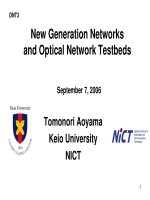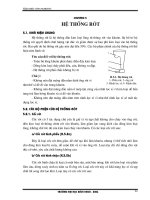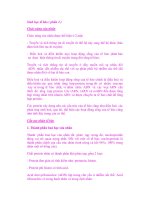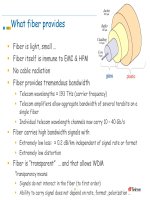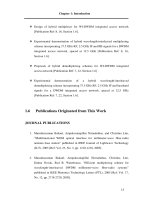Column Generation for WDM Optical Network Design phần 2 ppsx
Bạn đang xem bản rút gọn của tài liệu. Xem và tải ngay bản đầy đủ của tài liệu tại đây (94.9 KB, 12 trang )
Column Generation – main steps
Solve restricted
master problem
For all
commodities
(s, d)
Using costs computed in the
previous 2 steps, find the shortest
path for commodity (s, d)
Compute Pz,(s,d) for all z already
in the model
Length of SP <
w(s,d)?
Any new lightpaths
used in the SP?
Add new flow path
variables
Add new lps and
corresponding constraints
Reduced cost
nonnegative for
all commodities?
LP solved
Compute Pz,(s,d) for all z not in
the model by solving the all-pair
SP problem
Yes
Yes
Yes
No
No
No
Branching Strategy
• Efficient branching strategy for ODIMCF problem (Barnhart
et al.):
– Identify 2 fractional paths for the fractional flow with greatest
demand and create 2 children nodes using the following rule:
– Let A be a set of arcs originating at divergence node (D). Define 2
subsets of arcs A1 and A2, such that E ∈ A1, F ∈ A2, |A1| ≈
|A2|, A1∩ A2 = Ø, and A1 ∪ A2 = A.
– Create one child node that does not use any arcs in set A1, and
one child node that does not use any arcs in set A2
– Important property: Proposed branching strategy does not
destroy the structure of the pricing problem.
A DC B
F
E
Branching Strategy (cont.)
• Since a single flow path in the WDM OND problem may
visit the same node more than once, we cannot apply
similar branching strategy.
Example
• Solution: Apply branching strategy that prohibits use of
certain arcs only for specific lightpaths of a given
commodity
A DC B
F
E
Flow path A →B
using lps:
A →F {A, C, D, F}
F →B {F, D, E, B}
Branching Strategy (cont.)
• Step 1. Check if there are any commodities with fractional
traffic. If there is no such commodity go to Step 4.
• Step 2. Identify commodity with greatest demand that has
fractional lost traffic.
• Step 3. Create 2 new nodes:
– Node 1: Set H
(s,d)
= 1
Do not serve demand for commodity (s,d) in the final solution
– Node 2: Set H
(s,d)
= 0
Serve demand for commodity (s,d) in the final solution
Branching Strategy (cont.)
• Step 4. Identify 2 paths with the greatest fractions of flow
for commodity (s, d) selected in Step 1.
• Step 5. If the 2 selected flow paths do not differ in the
logical layer, go to Step 7.
• Step 6. Locate divergence node in the logical layer and
create 2 new nodes (by first identifying 2 disjoint and
exhaustive sets of lightpaths emanating from divergence
node)
– Node 1: for commodity (s, d) forbid all lps in the first set of arcs
– Node 2: for commodity (s, d) forbid all lps in the second set of
arcs
Branching Strategy (cont.)
• Step 7. Locate divergence node d in the physical layer, and
identify wavelengths l1 and l2 on fibers originating at node
d that are being used by flow paths identified in Step 2.
• Step 8. Identify origin and destination of the lp (say O’→D’)
corresponding to wavelenghts and fibers identified in Step
7.
• Step 9. Create 2 new nodes:
– Node 1: If l1 and l2 are on different fibers do not allow allow
commodity (s, d) to use any lps O’ →D’ that use fiber l2 belongs
to. Otherwise, do not allow commodity (s, d) to use any lps O’
→D’ that use l2.
– Node 2: If l1 and l2 are on different fibers do not allow allow
commodity (s, d) to use any lps O’ →D’ that use fiber l1 belongs
to. Otherwise, do not allow commodity (s, d) to use any lps O’
→D’ that use l1.
Applicability of the proposed BP algorithm to
WDM OND with alternative design objectives
• Only minor modifications in computation of reduced
cost are necessary when considering alternative
design objectives, such as:
– Quantity / cost of node equipment
– Average hop distance over all flow paths in the network
• Overall Column Generation Algorithm and the
Proposed Branching Strategy remain valid in all
cases
Preliminary Computational Results
Node Nbr Commodity Nbr Demand LB UB cpu (seconds)
5 20 H 0.11 0.73 0.516
5 20 L 0 0 0.188
5 10 H 0 0 0.109
5 10 L 0 0 0.094
7 42 H 4.018* 5.38 803.594
7 42 L 0 0.87 743.685
7 21 H 0.19 0.7 1.16
7 21 L 0 0.12 0.611
10 90 H 21.098* 23.18 4782.41
10 90 L 5.402* 8.22 4577.11
10 45 H 2.46* 4.1 3797.63
10 45 L 0 0.35 3617.45
20 380 H 152.451 155.44 2233.76
20 380 L 70.74 86.84 2587.49
20 190 H 52.794 57.29 2434.47
20 190 L 17.277 32.8 2280.26
Table 1. Minimizing lost traffic. Complete network with 2 fibers (fiber
capacity: 2 lightpaths) between all pairs of nodes, 3 transmitters and 3
receivers at each node. Demand H: uniformly random [0.1, 1], L: uniformly
random [0.1, 0.5].
Preliminary Computational Results
Node Nbr Commodity Nbr Demand LB UB cpu (seconds)
5 20 H 23.825* 28 48.516
5 20 L 16.439* 20 29.781
5 10 H 15.002* 16 3.015
5 10 L 11.57* 14 6.891
7 42 H 51.521* 62 3796.53
7 42 L 35.340* 42 3678.02
7 21 H 26.457* 32 55.922
7 21 L 18.658* 22 59.797
10 90 H 112.596* 134 5646.34
10 90 L 75.637* 180** 3149.42
10 45 H 56.666* 68 4076.89
10 45 L 39.248* 50 3926.81
Table 2. Minimizing total number of transmitters and receivers in the
network. Complete network with 2 fibers (fiber capacity: 2 lightpaths)
between all pairs of nodes. Demand H: uniformly random [0.1, 1], L:
uniformly random [0.1, 0.5].
Concluding Remarks
• Proposed Column Generation Algorithm for the WDM
optical network design can be used to test optimality of
solutions provided by existing heuristic procedures
• Application of the proposed procedures to WDM optical
network design with alternative design objectives requires
only minor modifications
• Efficiency of the proposed BP algorithm may be
significantly improved by resolving degeneracy issue.
References
• D. Banerjee and B. Mukherjee. Wavelength-routed optical
networks: Linear formulation, resource budgeting tradeoffs,
and a reconfiguration study. IEEE/ACM Transactions on
Networking, 8(5): 598-607, 2000
• C. Barnhart, C. A. Hane, and P. H. Vance. Using branch
and price and cut to solve origin-destination integer
multycommodity flow problems. Operations Research,
48(2):318-326, 2000
• R. Dutta and G. N. Rouskas. A survey of virtual topology
design algorithms for wavelength routed optical networks.
Optical Networks Magazine, January 2000
References (cont.)
• R. M. Krishnaswamy and K. N. Sivarajan. Design of logical
topologies: A linear formulation for wavelength-routed
optical networks with no wavelength changers. IEEE/ACM
Transactions on Networking, 9(2): 186-198, 2001
